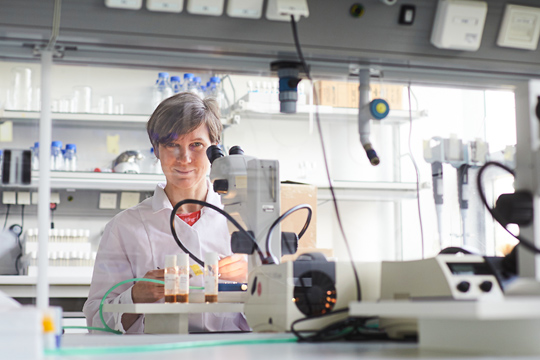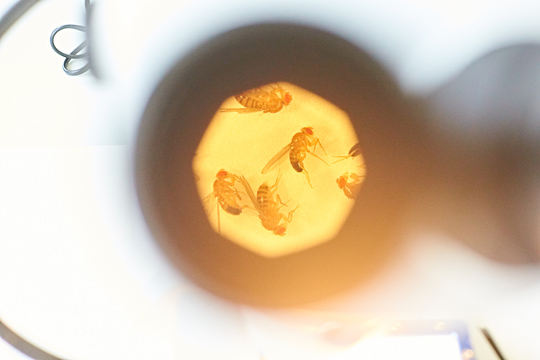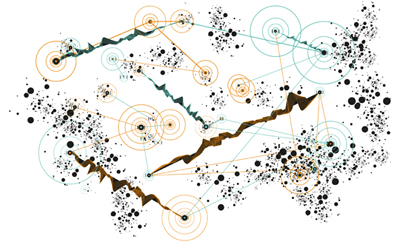Not all wounds heal according to plan
Freiburg, Apr 18, 2019
After an injury, a healing program is initiated in epithelial cells. They tightly coordinate themselves so that they do not divide too much or too little. Dr. Anne-Kathrin Classen from the Cluster of Excellence CIBSS - Centre for Integrative Biological Signalling Studies is investigating why this process sometimes goes awry. Using the model organism of the fruit fly Drosophila, the cell biologist is investigating which signalling pathways control tissue repair. At some point this knowledge could lead to better treatment for chronic wounds.
 Anne-Kathrin Classen wants to uncover the processes behind normal and impaired tissue regeneration. Photo: Harald Neumann
Anne-Kathrin Classen wants to uncover the processes behind normal and impaired tissue regeneration. Photo: Harald Neumann
Despite seemingly good planning, cells in injured tissues sometimes become uncoordinated. In tissue healing programs, this could lead to delayed tissue repair and chronic wounds. Cell biologist Anne-Kathrin Classen in the CIBSS Cluster of Excellence is investigating the molecular mechanisms behind normal and impaired healing and regeneration of tissues. The research group leader at the Center for Biological Systems Analysis (ZBSA) at the University of Freiburg is investigating how epithelial cells behave after tissue injuries. How does their healing program start? “It is also important to know how the cells return to their normal state,” says Classen who works with the model organism of the fruit fly Drosophila. Is it possible that new knowledge will eventually prevent chronic wounds? Classen also hopes to find out how cellular signalling pathways of tissue regeneration and tumor growth are connected.
Injuries stress the tissue
Injuries mean stress for the tissue. “The cells sense that something has been damaged,” explains Classen. First they process this information, then they communicate with surrounding cells and finally with the rest of the organism. “The cells coordinate which signalling pathways should be activated.” If everything goes well, the process leads to a healed and healthy tissue. For this, the cells must neither divide too much nor too little. According to the cell biologist, perfect healing is not always achieved: “There are situations in which the tissue does not find the right balance.”
Classen, who studied cell and developmental biology in Manchester and Amsterdam, explores tissue regeneration using the Drosophila model. With her 10-person team, she prepares the 0.3 millimeter small imaginal discs from the one millimeter larvae of the fruit fly: “This is one cell layer with up to 40,000 epithelial cells each.” Epithelial cells form the outer boundary layer of multicellular organisms, for instance the uppermost cell layer of skin and mucous membranes in humans.
|
Biological signals and signalling pathways Precise coordination is needed in order for trillions of cells to form, maintain and regenerate orderly tissues, organs and healthy organisms. To achieve this, complex communications processes take place between and within cells. Defects in these communications networks can lead to developmental disorders, immunodeficiency, cancer and other diseases. The CIBSS Cluster aims to achieve a comprehensive understanding of these communications processes – from the molecular level to the level of cells and organs. Furthermore, CIBSS research groups will investigate how these communications processes are connected to other important biological processes such as metabolism. Based on these new findings, the researchers will develop new possibilities to address challenges in areas as diverse as immunotherapy and the sustainable production of crops.
|
|
In order to investigate tissue repair, the researchers minimally wound the Drosophila larvae, either mechanically with small needles, or genetically, by manipulating epithelial cells in such a way that they produce excess amounts of the signalling factor TNF-α and thereby die. This leads to signals that start tissue repair: cells begin to proliferate. But not always, as is the case with impaired wound healing. “Our system serves as a model for this,” explains Classen. Her research group has shown that when wound healing is impaired, cell proliferation does not function properly because epithelial cells suffer from prolonged stress and cannot effectively coordinate the signalling pathways that promote healing.
Footprints on the DNA
The transcription factors AP-1, STAT and YAP play important roles in this process. Like other transcription factors, they switch their target genes on or off by binding to specific stretches of DNA in the genome. “We suspect that AP-1, STAT and YAP have significant roles in the tissue repair program,” says the cell biologist. She hopes to identify the target genes of these transcription factors. Do these genes ensure appropriate cell proliferation in the normal healing program?
Her research group couples genes for fluorescent proteins to the binding sites of STAT, AP-1 and YAP. When the transcription factors switch on one of their target genes, a fluorescent protein is produced. “This visual readout enables us to observe the activity of STAT, AP-1 and YAP in tissue under the microscope,” says the researcher. Alternatively, she can modify STAT, AP-1 and YAP themselves so that they leave a chemical footprint at their binding sites when they associate with DNA. “We isolate these binding sites and can characterize all them by sequencing.” With these and other methods, Classen hopes to unravel the transcription program that starts when injuries occur. How do cells initiate this program? How can they exit this program during normal wound healing, and why is this impaired during abnormal healing? “How do the epithelial cells that bring about normal or impaired tissue repair differ?” she asks.
 The researchers use the fruit fly Drosophila as a model organism - its signalling processes are similar to those of humans. Photo: Harald Neumann
The researchers use the fruit fly Drosophila as a model organism - its signalling processes are similar to those of humans. Photo: Harald Neumann
Curiosity leads to surprising ends
“I hope my basic research will one day improve people’s lives,” says Classen. She emphasizes the power of the Drosophila model. “Although fruit flies do not look like humans, their tissue processes are very similar and have been preserved through evolution. For example, transcription factors corresponding to STAT, AP-1 and YAP from Drosophila are also found in humans.” However, Classen believes that it will be years before the findings of her research reach patients. At any rate, the researcher will leave it to medical experts to develop specific therapies based on the results of her research - whether they be for tissue repair or cancer. “Many signalling pathways are active in both cases,” she says. “If we deactivate certain tissue repair programs, for example, tumor growth changes.” In the future, Classen intends to further investigate the question of how closely tissue regeneration and tumor growth are interlinked.
Classen says it is difficult to foresee exactly what she will be researching in ten years’ time. “Science has always led me along surprising paths,” she says. “I am driven by curiosity and the desire to get to the bottom of the new and unknown. I hope that our research will one day lead to a better understanding and treatment of diseases.”
Jürgen Schickinger
CIBSS – Centre for Integrative Biological Signalling Studies
CIBSS ist einer der beiden neuen Exzellenzcluster der Universität Freiburg. Darin werden mehr als 60 Arbeitsgruppen biologische Signalprozesse von Immunzellen, rund um Mitochondrien, in der Organentwicklung und in Wurzeln von Pflanzen erforschen. Die Wissenschaftlerinnen und Wissenschaftler kommen aus sechs Fakultäten – der Fakultät für Biologie, Mathematik und Physik, Medizin, Chemie und Pharmazie, Technik sowie der Fakultät für Rechtswissenschaften. Auch das Universitätsklinikum sowie das Max-Planck-Institut für Immunbiologie und Epigenetik sind beteiligt. Die Deutsche Forschungsgemeinschaft fördert den Cluster von Anfang 2019 bis Ende 2025.
CIBSS – Centre for Integrative Biological Signalling Studies


